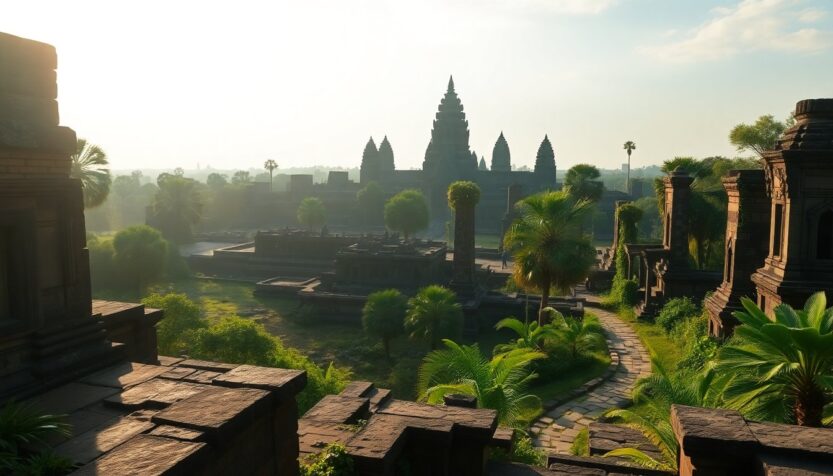My journey to the enchanting realm of the Ancient Khmer Empire in Cambodia led me to the remarkable site of Angkor, a UNESCO World Heritage location that has been captivating visitors for over a century. Known primarily for the iconic Angkor Wat, this vast archaeological treasure trove is a testament to the ingenuity of the Khmer civilization.
Traveling from the bustling capital, Phnom Penh, to the serene town of Siem Reap was an adventure in itself. While a flight is an option, we opted for a scenic bus journey that allowed us to soak in the beautiful landscapes. Siem Reap, a charming city, serves as the gateway to the ancient temples and offers diverse accommodations and culinary delights to suit every traveler’s budget.
Returning to Angkor: A Second Encounter
This marked our second expedition to Angkor, and unlike our previous visit, this time we chose a more personalized experience. Eleven years ago, we had a conventional tour guide who provided fascinating insights about the temples and their history. While a guided tour can be incredibly informative, we decided to embrace a different approach on this trip.
Our Personal Guide: Mr. Clean
Upon arriving in Siem Reap, we met a delightful tuk-tuk driver who would become our companion for the week. His name, translating to “clean,” led us to affectionately call him Mr. Clean. With his local expertise, we navigated the temples at optimal times, avoiding the throngs of tourists that often crowd the major sites. Mr. Clean not only whisked us away to Angkor Wat, but he also introduced us to hidden gems in the area that enhanced our experience.
Angkor Wat: The Heart of the Ancient City
At the core of this magnificent ancient city lies Angkor Wat, the largest religious structure globally, both ancient and contemporary. Spanning an impressive 402 acres, the temple was constructed between 1113 and 1150 AD, although the city itself dates back to the year 900. The architectural brilliance of the Khmer people is evident in the intricate designs and expansive layout of the temple.
The surrounding moat adds to the allure, extending over three miles and enhancing the temple’s grandeur. Angkor is also renowned for its sophisticated water management system, featuring canals and reservoirs that ensured a sustainable water supply for agriculture and daily life.
A Historical Transition
Originally built as a Hindu temple dedicated to Vishnu, Angkor Wat underwent a transformation around 1177 when the king converted to Buddhism due to the influence of his wife. This shift is reflected in the temple’s elaborate carvings, showcasing both Hindu and Buddhist motifs, alongside depictions of divine beings, historical battles, and scenes from royal life, all beautifully rendered over the expansive temple walls.
One of the most magical experiences is witnessing the sunrise over Angkor Wat. Despite the early start at 4:45 AM, the breathtaking sight of the sun rising behind the silhouette of the temple, coupled with its reflection on the water, makes it an unforgettable moment. Following Mr. Clean’s expert advice, we captured our photos and swiftly moved on to explore other temples.
Beyond Angkor Wat: A Tapestry of Temples
With two full days at our disposal, we ventured to Pra Thom Temple right after our sunrise excursion. This temple, built in 1186 from intricately carved stone blocks, is unique due to the tree roots that have intertwined with its structure, creating an otherworldly atmosphere. Our timing was flawless, as we enjoyed a rare moment of solitude, free from the usual crowds.
Healing at Neak Pean
Among the numerous temples, Neak Pean stood out with its serene beauty. Located on an island in Lake Baray, this temple is surrounded by four reservoirs symbolizing Earth, Wind, Fire, and Water. This balance was believed to be essential for healing, creating a tranquil space that radiated peace.
As we continued our exploration, we visited Preah Khan, a vast complex that once hosted royal palaces and a university. An intriguing structure within this area, known as the library, features Roman-style columns, although its original purpose remains a mystery.
The Enigmatic Bayon Temple
No visit to Angkor would be complete without witnessing the Bayon Temple. Often referred to as the temple of countless faces, it is adorned with 216 serene and smiling faces believed to represent King Jayavarman VII. The temple’s intricate carvings, coupled with the striking lichen that grows on the stones, creates a captivating visual experience.
Despite visiting Angkor twice, I am continually amazed by its vastness and the depth of its history. Once home to over a million people, the temples nestled in the jungle offer a unique adventure. Each intricate carving tells a story, inviting exploration and discovery.
Since its rediscovery by French explorer Henri Mouhot in 1860, Angkor’s legacy has captured the imagination of the world. Although it never truly disappeared from local knowledge, his accounts brought it back into the spotlight. Today, over two million visitors annually come to marvel at its beauty, making it an essential stop for those fascinated by ancient civilizations.
While not everyone may be drawn to ancient ruins, the grandeur of the Angkor complex should be on every traveler’s list. If you’re intrigued by history and culture, this destination promises to leave a lasting impression.






